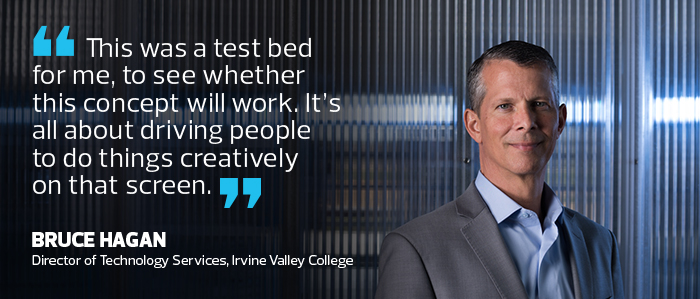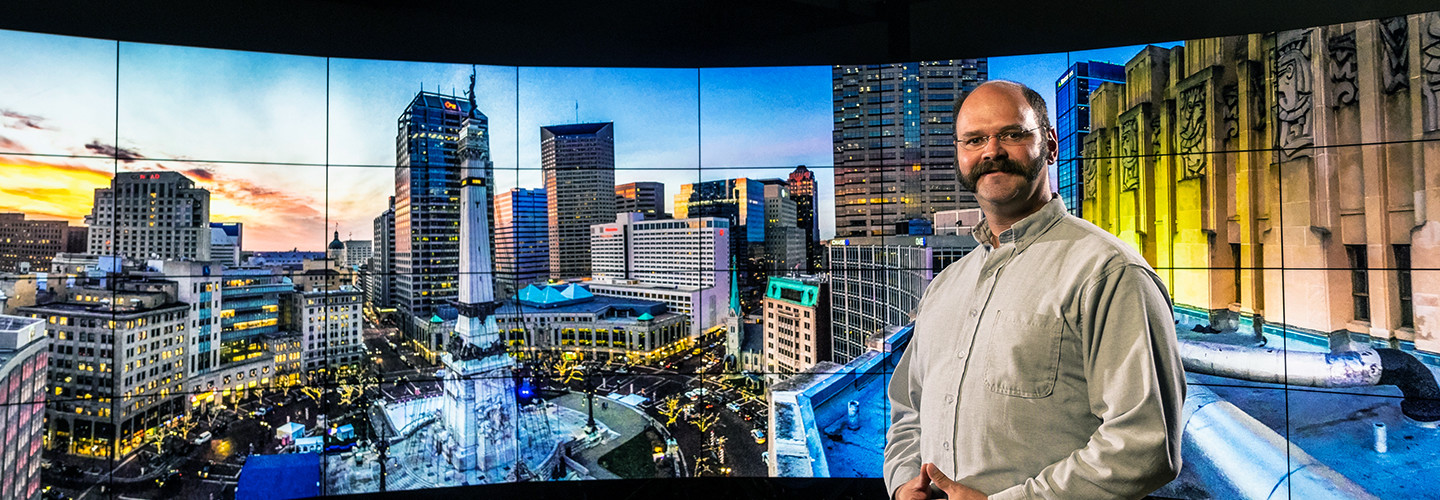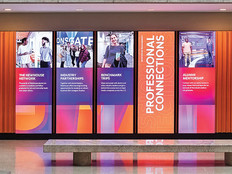Video Walls Bring Campus Highlights to the Big Screen
Asking how Indiana University uses its video walls is a bit like asking how the institution uses its buildings. The answer, in both instances is, “For everything.”
The Big Ten institution installed its first video wall — a collection of large, high-resolution displays connected to create the appearance of one enormous screen — in 2004. Five years later, the IT shop created an original design for what the university dubbed the IQ-Wall, each of which is run by a Dell workstation. The largest of these, at the Informatics and Communications Technology Complex on IU’s Indianapolis campus, features 66 million pixels of resolution.
Today, Indiana University continues to add IQ-Walls, using Planar displays for the most recent installations. At last count, 16 IQ-Walls were up and running, with four more set to come online soon.
“They’re all over our campuses,” says Chris Eller, principal project analyst at University IT Services’ Advanced Visualization Lab. “We have them everywhere, from specialized research labs to operations centers to classrooms, all the way up to fully public library lobbies and public atriums. You could walk into some of these buildings when they’re open and log in, and you could be using one.”
Falling costs encourage institutions to adopt video walls and digital signage, says Vern Freedlander, president of Toronto-based IT consulting firm Grace Street Media.
Much of the draw, he says, is the eye-catching nature of the walls, which can broadcast high-definition, 24-foot-high (or even taller) marketing messages that are virtually impossible to ignore.
The walls can serve multiple purposes, he says: branding campaigns, campus news and event calendars, wayfinding, advertising and emergency notification systems.
“The nature of a video wall is a dramatic presentation to get people’s attention very quickly,” Freedlander says. “However, in a well-planned digital signage rollout, you want that video wall to perform a variety of other communications tasks.”
SIGN UP: Get more news from the EdTech newsletter in your inbox every two weeks!
Video Walls Display Unlimited Potential
At Irvine Valley College, a community college in California, officials installed a square, nine-panel video wall from NEC in the common area of a new engineering building. Each screen is 46 inches wide, and the entire system is powered by a Lenovo ThinkCenter M710 and a content management solution from Four Winds Interactive.
The building opened recently, and the video wall was used for presentations at the grand opening ceremony. When the wall is idle, the college uses it to display information about the energy performance of the building, which is equipped with an array of solar panels.

To give the building flexibility for the future, Irvine Valley College also incorporated digital signage throughout, says Director of Technology Services Bruce Hagan.
“I wanted digital wayfinding and signage,” he says. “The set of classrooms that are in there today might not be the same set of classrooms that are there in five years. When I saw that this building was going to have an events space, I thought, ‘Where am I going to put a screen and a projector for events?’ The only thing I could figure out was a large video array.”
While Hagan says the video wall is first and foremost a marketing play, he’s also curious to see what types of use cases students, faculty and staff come up with on their own. “This was a test bed for me, to see whether this concept will work,” he says. “It’s all about driving people to do things creatively on that screen.”
Make Signage Accessible for Students as well as Teachers
Indiana University had a similar reason for placing video walls around its several campuses: to democratize the technology by giving not only faculty but also students and other users the ability to display content in a way that commands attention.
“We wanted to lower the barrier to entry,” says Eller. “We wanted to make it easier to see — and to do — visualization.”
Video walls can bring scientific software to life, with vibrant colors and a large number of pixels that let viewers see both tiny details and broader context at once. For example, someone could use a video wall to display mapping software.
The audience would be able to make out the individual streets of a neighborhood, along with how that neighborhood fits into its larger city. This functionality has applications for graphic designers, web developers and engineers, Eller says, but also for nontechnical individuals, such as writers.
“I’ve seen students pull up their papers in Word documents and review them on a video wall,” he says. “They don’t have to flip through pages. They just walk down the wall five feet and then they move back.”
Artists have connected Indiana University’s video walls to motion-tracking systems, creating dynamic digital art exhibits. The university has even let students use a video wall to watch a varsity soccer game together. “We let people log in and go to town,” Eller says. “We don’t care exactly what you do with it. We just want you to do something useful or interesting with it.”
One caveat: Before relying on video walls for high-profile events, thoroughly test the equipment. A presentation at Irvine Valley College had to be scuttled because presenters couldn’t find the remote control for the wall. “It was heartbreaking,” says Hagan. “After that, we bought three more remotes, just in case.”
Create Content and Encourage Campus Contributions
Troy University in Alabama installed a Planar Clarity Matrix MultiTouch LCD Video Wall System in a six-by-two configuration in its new administrative building in 2017. The interactive wall, divided into three segments, primarily serves prospective students, who view videos about campus life, housing and athletics as they wait for campus tours to start. At other times, the screens broadcast images from the university’s Instagram account.
“You’ve got to find differentiators in higher education today,” says Dendy Moseley, Troy’s associate director of enrollment management. “It’s such a competitive marketplace. We want one of our differentiators to be that Troy is on the cutting edge, that when you come to Troy you’re going to receive a different experience. This is a way to send that message.”

Photo: Peter Bohler
While the wall is flashy, Moseley says, it also gives the university a way to deliver important information. “We spent a lot of time building the content that’s in those videos,” he says. “Once you get into the content, it’s less flash and more substance.”
As technology improves and costs come down, Freedlander says, the main challenge will be devising policies and strategies around content. “It requires new processes to be implemented in a campus communications office, from approvals of the content to programming the messaging,” he says. “One of the pain points is how to keep the content fresh and timely and relevant.”
Strategically Plan Content Before Deploying Video Wall Tech
While video walls can spur creativity, Freedlander suggests that institutions consider their content strategy before implementing the technology. “I think you have to have a planned approach,” he says. “Viewers have become much more sophisticated, and they really expect a greater level of consistency to the content.”
Often, IT staff will partner with employees from other departments, such as marketing, communications, athletics and public safety, to coordinate the development and timing of content around events, messaging campaigns and other initiatives.
Eller agrees that early use cases for video walls should be planned. But after that, he says, users should drive much of the content strategy. “I think you want to have a couple of use cases in mind to seed the effort,” he says. “You want to have someone who can manage it and generate some content. But generally, it should take off on its own.”
At one Indiana University campus, Eller says, officials used a video wall to hold a remote graduation ceremony for a student who couldn’t make it back to campus.
“That was a use case we hadn’t anticipated,” Eller says. “They remotely graduated the student, and the chancellor was there, and it looked really cool on the wall. We hear these stories, and we say, ‘That’s a good idea. Let’s share that back out with the campus community.’”








